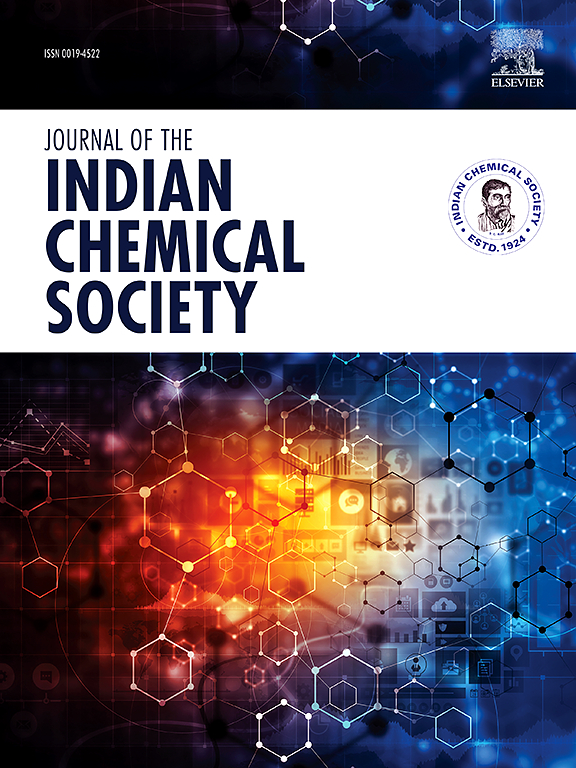Tb3+活化Mg2SnO4多色发光荧光粉的第一性原理研究:变压下的光学和热力学性质
IF 3.2
4区 化学
Q2 CHEMISTRY, MULTIDISCIPLINARY
引用次数: 0
摘要
利用密度泛函理论(DFT)原理,对新开发的荧光粉(Tb3+:Mg2SnO4)的结构、电子、带隙特性、光学和热力学属性进行了全面的分析。目前对荧光粉材料的研究往往面临着如何实现稳定的多色发射,并具有适合先进光电应用的可调特性的挑战。特别是,缺乏关于稀土掺杂如何影响复杂主体晶格的光学、热力学和电子行为的理论见解。本研究的基本目标包括揭示Tb3+掺杂Mg2SnO4荧光粉在二维(2D)和三维(3D)配置下可调节颜色发射的复杂能力。声子带结构中虚频率的缺失证实了两相的动态稳定性。这项研究的发现揭示了Tb3+:Mg2SnO4在2D-Tb-Mg和3D-Tb-Mg位点上引人注目的光学响应性,分别产生明显的橙色和绿色发射。值得注意的是,这种创新的荧光粉在其2D和3D结构中显示出0.3和1.5 eV的直接带隙,这支持了其可调光发射的潜力。利用准谐波Debye模型计算了Tb3+掺杂Mg2SnO4的热力学性质。结果表明,吉布斯自由能随温度的升高而平稳下降,证实了材料在较宽的温度和压力范围内的热力学稳定性。这表明该化合物适合高温应用,如光电和LED器件。我们的研究结果表明,Tb3+活化的Mg2SnO4是一种多色发光(橙色和绿色)荧光粉,是电子和光电子应用的潜在候选者。这种特殊的多用途颜色可调荧光粉在光电和固态照明领域的广泛应用中具有巨大的潜力。本文章由计算机程序翻译,如有差异,请以英文原文为准。
First principle investigation of Tb3+ activated Mg2SnO4 multicolor emitting phosphor: optical and thermodynamic properties under varying pressure
The current investigation delves into a comprehensive analysis of the structural, electronic, bandgap characteristics, optical, and thermodynamic attributes of a newly developed phosphor (Tb3+:Mg2SnO4), utilizing density functional theory (DFT) principles. Current research on phosphor materials often faces challenges in achieving stable multicolor emission with tunable properties suitable for advanced optoelectronic applications. In particular, there is a lack of theoretical insight into how rare-earth doping affects complex host lattices' optical, thermodynamic, and electronic behavior. The fundamental objectives of this study encompass unraveling the intricate capacity of Tb3+ doped Mg2SnO4 phosphor for adjustable color emissions in both its two-dimensional (2D) and three-dimensional (3D) configurations. The absence of imaginary frequencies in the phonon band structures confirms the dynamic stability of both phases. The findings of this study unveiled the compelling optical responsiveness of Tb3+:Mg2SnO4 across the 2D-Tb-Mg and 3D-Tb-Mg sites, giving rise to distinct orange and green emissions, respectively. Notably, this innovative phosphor exhibits a direct band gap of 0.3 and 1.5 eV for its 2D and 3D structures, which supports its potential for tunable light emission. The thermodynamic properties of Tb3+-doped Mg2SnO4 were calculated using the quasi-harmonic Debye model implemented via the Gibbs2 code. The results show that the Gibbs free energy decreases smoothly with increasing temperature, which confirms the thermodynamic stability of the material across a wide temperature and pressure range. This indicates the compound's suitability for high-temperature applications, such as in optoelectronic and LED devices. Our findings show that Tb3+ activated Mg2SnO4 is a multicolor-emitting (orange and green) phosphor and a potential candidate for electronic and optoelectronic applications. This particular variety of versatile color-tunable phosphors holds immense potential across an extensive array of applications within the realm of optoelectronic and solid-state lighting applications.
求助全文
通过发布文献求助,成功后即可免费获取论文全文。
去求助
来源期刊
CiteScore
3.50
自引率
7.70%
发文量
492
审稿时长
3-8 weeks
期刊介绍:
The Journal of the Indian Chemical Society publishes original, fundamental, theorical, experimental research work of highest quality in all areas of chemistry, biochemistry, medicinal chemistry, electrochemistry, agrochemistry, chemical engineering and technology, food chemistry, environmental chemistry, etc.

 求助内容:
求助内容: 应助结果提醒方式:
应助结果提醒方式:


